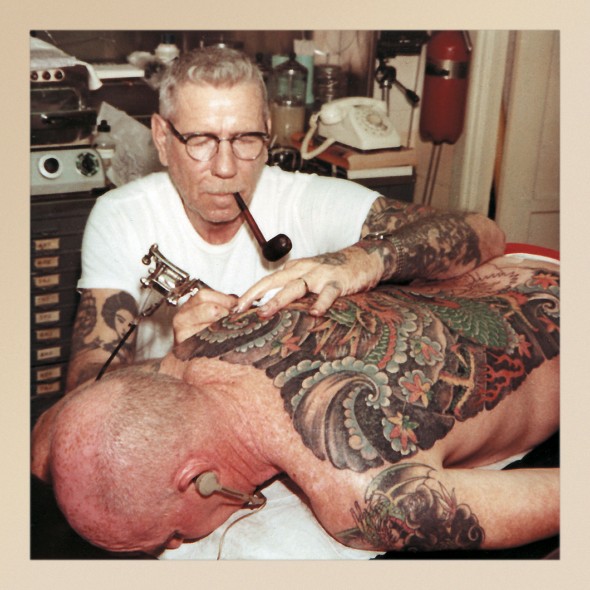
After a trip to Coney Island, tattoo artist “Philadelphia” Eddie Funk recounts: “I wanted a skull and crossbones like the pirate flag!” Drinking, sex and body art (“stewed, screwed and tattooed”) are the muses of Hori Smoku Sailor Jerry, a documentary featuring artists like Funk and Ed Hardy recounting tales of the infamous “F**in’ Sailor Jerry.” Based on a recipe found in his belongings after his death, the company that produces the rum founded around Norman Keith Collins (better known as Sailor Jerry) sponsored public summer screenings of the Erich Weiss film in NYC, SF, LA, Austin and Portland (the five golden rings of US cities). Other than the obvious (sell rum), why get his name back out there? The inkers wanted to set the record straight. With a generation of supposed adults unknowingly raised on the Sailor Jerry tattoos sported by Blink 182, Sugar Ray, the Spice Girls and (wait for it…) Jesse James of bollocksing Sandra Bullock infamy (and West Coast Choppers fame), it was time to educate the public as to where these tattoos came from. Here’s the skin skinny: turns out hookers, drinking and a plenitude of naval neophytes testing purple pigment feature prominently in promulgating the skin worn pics.
Born in Reno in 1911, Jerry joined the Navy, and set about sailing the Pacific, linking Japanese art with tattooing. Credited with more or less inventing classic flash tattooing“American Style,”Jerry’s pupils included Ed Hardy (of t-shirts for sale fame) and Mike Malone. If you are a tattoo aficionado, then Sailor Jerry’s tattoos are as recognizable as Heidi Fleiss in a Sheen family album. His most infamous are the iconic booze, snakes, cats, eagles, dice, knives and guns. From his tattoo shop in Honolulu, Jerry started out with rub-offs using old rpm needles, and eventually got his own radio show where he ranted about the government and read poetry. His title of “Hori Smoku” was both racist and reverential. He was accepted by the Japanese masters, and fused Japanese water shading into his technique. Harkening to a time when sailors “who had the clap really had the clap,” Erich Weiss’ film celebrates the macho art form of rebellious rock ‘n’ roll angst and reminds us of Hawaii’s influence on American culture (things really take off when Pearl Harbor is bombed and the eventual melding begins). If the documentary film is the modern day memoir, this one, about a tattoo artist who hated Nixon for “being too liberal” and died in 1973, is a top-shelf label that may inspire you to look into the next gallery of the “genius epidermis picturis” with a little less scorn and a little more fear.
-Gabriel Leif Bellman
Photography by Sailor Jerry Rum

